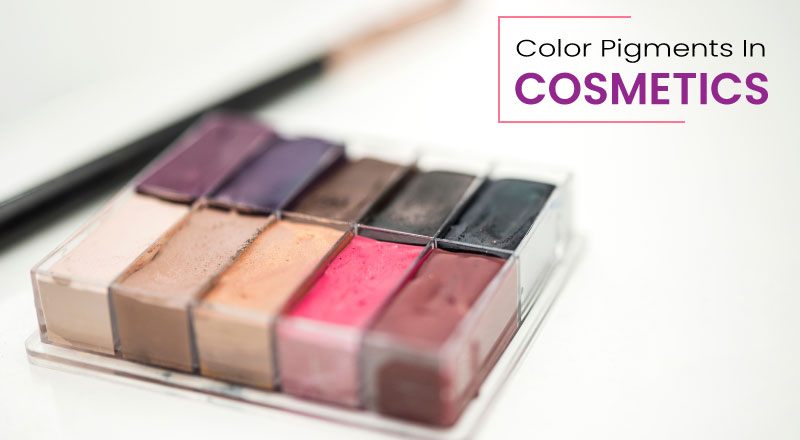Most Popular

Cosmetic lakes and cosmetic pigments have come a long way with innovative research catering to the increasing demand for better shades by consumers. These days, brands are investing heavily in research and development labs. Safety standards continue to emphasize on controlling the presence of heavy metals in cosmetic colours such as color pigments for prevention of health concerns.
Let’s take a closer look at the world of color pigments for cosmetics.
Purpose Of Cosmetic Colors
In cosmetics, colors are used to indicate a lot of things. The most common reason for giving so much colors is for spoiling the consumer with choice of numerous shades to go with their attire. This idea is promoted mainly for selling nail colors and lipsticks. Colors can be used to complement the product packaging colors as well.
Different Types Of Color AdditivesIn Cosmetics
For cosmetics, there are two types of color additives: Organic and Inorganic. Organic colors contain carbon atoms while inorganic colors have a mineral base.
Organic colors are of two types: Organic Lakes and Organic Pigments. Synthetic dyes and lake colors such as aluminium lakes come under organic colors. Organic dyes can be oil soluble or water soluble. There are very few oil soluble dyes that are approved for use in cosmetics. Organic pigments consist of lakes and botanically derived colors.
Inorganic colors consist of pigments such as ultramarines, titanium dioxide etc. Oxides such as zinc oxides, iron oxides etc. are also inorganic colors. Additional treatments are used to enhance the characteristics of the colors. Enhancements such as sheen, UV protection, water-resistance etc. are achieved in cosmetic products by performing specific color treatments.
Safety Before Variety
There are a number of color variants that can be developed using the color additives available in the market. So, can any color be used for making cosmetics? Not really. Specific colors in prescribed consistencies have to be used for manufacturing of specific cosmetics.
Cosmetic dyes approved for lip products may not be approved by use on the eyes. Also, the colors suitable for people of a specific skin type in one nation may not be suitable for people with a varying skin type from another nation. The rigorous nature of the tests for cosmetic colours is put in place by regulatory authorities to ensure that the ingredients in the colors do not harm the end user of the cosmetics.
Cosmetic manufacturers have to therefore work along with reputed cosmetic colours manufacturers to develop cosmetic lakes and cosmetic pigments as per the laws of the country where the cosmetic products are intended to be marketed and sold.
Color codes and color numbers on cosmetic labels are clearly printed on the cosmetics for users to understand the approved colors used in the products. USFDA is one of the leading authorities with specific guidelines for use of cosmetic colors. Color Index (CI) is the standard for identifying colors for cosmetics meant for the European Union regions.
To cater to the needs of cosmetics companies, several facilities in Asian counties such as India are well-equipped. Reputed businesses are capable of producing cost-effective, high quality cosmetics using cosmetic lakes, cosmetic pigments and cosmetic dyes in India that comply with the USFDA, EU and other markets where the demand for color cosmetics is high.
Busting The Myth Of Heavy Metal In Cosmetic Colors
There is no denying the fact that impurities or intentional actions can lead to excessive concentrations of heavy metal such as arsenic, lead, mercury, zinc, iron, cadmium, aluminium or chromium in cosmetics. Human skin exposure to these heavy metal elements in cosmetics has been a concern due to the health issues connecting them with nervous system toxicity, reproduction issues, etc. According to a study, metals did not pose a potential health hazard for humans if used as per safety guidelines.
Be it the USFDA, World Health Organization (WHO) or the European Union (EU) standards, there is a parameter of Maximum Allowable Concentration (MAC) or similar with conditions for helping manufacturers and consumers to understand the permissible limits of metals in cosmetic products.If you notice, most studies will tell you about the side-effects of excessive use of heavy metal in cosmetics. This means that consumers can safely use beauty or healthcare products with metal concentrations that are within the safety limits.
With reliable monitoring, testing and quality assurance procedures, safer cosmetic colours can be manufactured for consumers. Today, Koel colors is one of the trusted producers of safety-complaint cosmetic colours because the company follows stringent workflows to control heavy metals in cosmetic dyes and cosmetic pigments.
—
Learn more about safer color pigments in cosmetics with the assistance of the color experts at Koel Colors. To know more, contact +91 22 6825 2300.